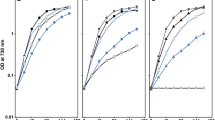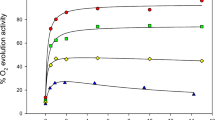Abstract
A study was made of the fluorescence induction curves from gently-broken spinach chloroplasts inhibited with DCMU. It was found that there were four kinetically different phases associated with such curves of which only the fastest did not appear to follow exponential kinetics. A comparison of the effects of various concentrations of DCMU on the rate of oxygen evolution and on the fluorescence induction curve did not support the hypothesis that any of the kinetic phases was simply an artefact caused by incomplete inhibition of electron transport. It was also found that 5 min of dark incubation did not maximally oxidize the electron acceptors to photosystem 2 since some acceptors were only oxidized following far-red illumination, suggesting a heterogeneity among these acceptors with respect to their re-oxidation properties. Investigation of the effect of the Q400 oxidation state on the fluorescence induction curve revealed that it only influenced the slowest kinetic phase and that Q400 did not seem to be associated with the other phases.
Similar content being viewed by others
Abbreviations
- DCMU:
-
3-(3′,4′-dichlorophenyl)-1
- 1′:
-
dimethylurea
- PS 1:
-
photosystem 1
- PS2:
-
photosystem 2
- HEPES:
-
N-2-Hydroxyethylpiperazine-N′-2-ethanesulfonic acid
- EDTA:
-
ethylene-diaminetetraacetic acid
- Fmax :
-
maximum yield of fluorescence emission
- F0 :
-
initial yield of fluorescence emission
- Fv :
-
variable yield of fluorescence emission
- N.E.:
-
non-exponential kinetics
References
Albertsson P-A and Yu S-G (1988) Heterogeneity among Photosystem IIa. Isolation of thylakoid membrane vesicles with different functional antennae size of Photosystem IIa. Biochim Biophys Acta 936: 215–221
Allen KD and Staehelin LA (1989) A new green gel system that resolves sixteen to twenty chlorophyll-protein complexes from Chlamydomonas Reinhardtii thylakoids. Physiol Plant 76: (3, pt 2) A180
Anderson JM and Melis A (1983) Localization of different photosystems in separate regions of chloroplast membranes. Proc Natl Acad Sci USA 80: 745–749
Bell DH and Hipkins MF (1985) Analysis of fluorescence induction curves from pea chloroplasts. Photosystem II reaction centre heterogeneity. Biochim Biophys Acta 807: 255–262
Bennoun P and Li YS (1973) New results on the mode of action of 3,-(3,4-dichlorophenyl)-1,1-dimethylurea in spinach chloroplasts. Biochim Biophys Acta 292: 162–168
Bouges-Bocquet B (1973) Limiting steps in photosystem II and water decomposition in Chlorella and spinach chloroplasts. Biochim Biophys Acta 292: 772–785
Bowes JM, Crofts AR and Itoh S (1979) A high potential acceptor for Photosystem II. Biochim Biophys Acta 547: 320–335
Chylla RA, Garab G and Whitmarsh J (1987) Evidence for slow turnover in a fraction of Photosystem II complexes in thylakoid membranes. Biochim Biophys Acta 894: 562–571
Dennenberg RJ and Jursinic PA (1985) A comparison of the absorption changes near 325 nm and chlorophyll a fluorescence characteristics of the Photosystem II acceptors Qa and Q400 Biochim Biophys Acta 808: 192–200
Duysens LNM and Sweers HE (1963) Mechanism of two photochemical reactions in algae as studied by means of fluorescence. In: Studies on Microalgae and Photosynthetic Bacteria (Japanese Society for Plant Physiology), pp 353–372. University of Tokyo Press, Tokyo
Heber U (1973) Stoichiometry of reduction and phosphorylation during illumination of intact chloroplasts. Biochim Biophys Acta 305: 10–152
Hodges M and Barber J (1986) Analysis of chlorophyll fluorescence induction kinetics exhibited by DCMU-inhibited thylakoids and the origin of α and β centres. Biochim Biophys Acta 848: 239–246
Hodges M, Packham NK and Barber J (1985) Modification of Photosystem II activity by protein phosphorylation. FEBS Lett 181: 83–87
Ikegami I and Katoh S (1973) Studies on the chlorophyll fluorescence in chloroplasts II. Effect of ferricyanide on the induction of fluorescence in the presence of 3-(3,4-dichlorophenyl)-1,1-dimethylurea. Plant Cell Physiol 14: 829–836
Jensen RG and Bassham JA (1966) Photosynthesis by isolated chloroplasts. Proc Natl Acad Sci USA 56: 1095–1101
Joliot A and Joliot P (1964) Étude cinétique de la réaction photochimique libérant l'oxygène au cours de la photosynthèse
Joliot P, Joliot A and Kok B (1968) Analysis of the interactions between the two photosystems in isolated chloroplasts. Biochim Biophys Acta 153: 635–652
Kok B, Forbush B and McGloin M (1970) Cooperation of charges in photosynthetic O2 evolution — 1. A linear four step mechanism. Photobiochem Photobiol 11: 457–475
Melis A and Anderson JM (1983) Structural and functional organization of the photosystems in spinach chloroplasts. Antenna size, relative electron-transport capacity and chlorophyll composition. Biochim Biophys Acta 724: 473–484
Melis A and Homann PH (1975) Kinetic analysis of the fluorescence induction in 3-(3,4-dichlorophenyl)-1,1-dimethylurea poisoned chloroplasts Photochem Photobiol 21: 431–437
Petrouleas V and Diner BA (1986) Identification of Q400, a high potential electron acceptor of Photosystem II, with the iron of the quinone-iron acceptor complex. Biochim Biophys Acta 849: 264–275
Petrouleas V and Diner BA (1987) Light-induced oxidation of the acceptor-side Fe(II) of Photosystem II by exogenous quinones acting through the OB binding site. I Quinones, kinetics and pH-dependence. Biochim Biophys Acta 893: 126–137
Schreiber U and Pfister K (1982) Kinetic analysis of the light-induced chlorophyll fluorescence rise curve in the presence of dichlorophenyldimethylurea. Biochim Biophys Acta 680: 60–68
Sinclair J (1972) Reversible abolition of enhancement in isolated spinach chloroplasts. Plant Physiol 50: 778–783
Sinclair J and Spence SM (1988) The analysis of fluorescence induction transients from dichlorophenyldimethylureapoisoned chloroplasts. Biochim Biophys Acta 935: 184–194
Vernon LP (1960) Spectrophotometric determination of chlorophylls and pheophytins in plant extracts. Anal Chem 32: 1144–1150
Wraight CA (1985) Modulation of herbicide-binding by the redox state of Q400, an endogenous component of Photosystem II. Biochim Biophys Acta 809: 320–330
Author information
Authors and Affiliations
Rights and permissions
About this article
Cite this article
Sinclair, J., Spence, S.M. Heterogeneous photosystem 2 activity in isolated spinach chloroplasts. Photosynth Res 24, 209–220 (1990). https://doi.org/10.1007/BF00032308
Received:
Accepted:
Issue Date:
DOI: https://doi.org/10.1007/BF00032308




